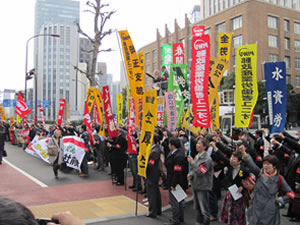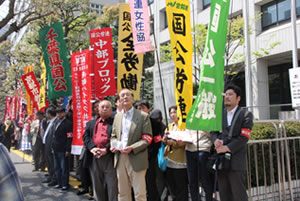Working poor among public employees in national and local governments
(Excerpt from the keynote report to the Assembly on the Struggle to Erase Working Poor Public Employees)
Public sector workers are under attack amid cutbacks on total labor costs being carried out through unjustifiable wage cuts and uniform job cuts.
That’s what has happened at the national level and is spreading to local levels. Public sector jobs are being done by contingent (or casual) workers or outsourced for the purpose of holding down costs as much as possible. The number of temporary and non-permanent workers has reached 70,000 at government offices, 700,000 at local government offices, 200,000 at public schools, and 200,000 at postal services. These numbers are increasing.
Today, contingent workers are an essential workforce in public service workplaces. Public workers, whether they are permanent or contingent, are making day-to-day efforts to provide better public services. But contingent workers are forced to endure very inadequate working conditions and low wages. This is how working poor are being produced in the public sector, making many workers feel uneasy about their employment contracts.
Aiming to turn Japan into the best country in the world for companies to do their business, Prime Minister ABE Shinzo’s administration is pushing ahead with adverse labor law reform to further carry out regulatory reform by easing labor market regulation to drive more and more workers into unstable contingent work. The move is permeating into the public sector. At a time when more than a third of Japanese workers are contingent workers, we must pursue the way for not only public workers but all workers to work with human dignity.
Japan has not ratified ILO Convention No. 111 (concerning anti-discrimination in employment and jobs) and ILO Convention No. 175 (concerning equal treatment of part-time workers with comparable full-time workers). But it is natural to guarantee internationally decent wages and other working conditions for all contingent employees.
The actual state of government contingent workers
Increasing contingent workers
 With the government and the business sector are teaming up to promote the policy of holding down wages, an increasing number of people are being impoverished and young people are facing enormous difficulty in finding jobs. There is an increasing need for public services amid worsening people’s livelihoods. Administrative authorities are called upon to respond to the diverse needs of people. In complete disregard of people’s needs, the government has carried out job cuts with uniformity, forcing each of the remaining employees to shoulder heavier workloads. This makes the implementation of administrative work even more difficult. Such is the situation in which contingent workers are essential for adequately providing public services. With the government and the business sector are teaming up to promote the policy of holding down wages, an increasing number of people are being impoverished and young people are facing enormous difficulty in finding jobs. There is an increasing need for public services amid worsening people’s livelihoods. Administrative authorities are called upon to respond to the diverse needs of people. In complete disregard of people’s needs, the government has carried out job cuts with uniformity, forcing each of the remaining employees to shoulder heavier workloads. This makes the implementation of administrative work even more difficult. Such is the situation in which contingent workers are essential for adequately providing public services.
As of July 2013, government offices had about 70,000 contingent workers (according to the International Affairs and Communications Ministry), who support the running of services along with permanent employees. About 70 percent of those contingent workers work more than 75 percent of work time for permanent workers. The number of contingent workers rose about 4,600 during 4 years from 2009. Today one out of five employees is a contingent worker.
More jobs being outsourced to the private sector
The government has advocated a small government as a pillar of its neoliberal national remolding. Under a “small government” the state’s “planning” division and the “executing” division will be separated (according to the basic law on the reform of administrative agencies). The “planning” division will be undertaken directly by public service employees. But at the same time, the government in 2007 introduced a new personnel evaluation program - an application of private sector management methods. In the executing wing, market testing, independent agency with employees that are not treated as public service employees (transition to privatization) and other measures of privatization and outsourcing have been taken. The business sector and large corporations are seeking to use their surplus capital by asking the government to provide them with investment opportunities. The government is responding to their demand by establishing law on market testing and by introducing a designated administrator system allowing public facilities to be run by private sector companies. The market testing law has provided a framework for the financial circles and large corporations to make inroads into public services. This law paved the way for the outsourcing of several public services to the private sector such as collection of national pension tax (Japan Pension Service, 12.6 billion yen saved) and issuance of certifications of registration (Justice Ministry’s register offices, 4.8 billion yen saved). Currently, about 300 public services have been up for competitive tendering under the market testing law and outsourced to the private sector.
Non-permanent employees in labor administration offices
In places of work in the labor administration offices, job cuts have been carried out every year. The number of employees decreased to 21,193 from 23,678 between 1997 and 2013. By contrast, non-permanent employees have been increasing year by year. About 20,000 non-permanent workers are working at the public job placement offices. More than half of consultation work for general jobs is assigned to non-permanent workers. Costs for hiring non-permanent workers are a part of the operation costs, the amount of which is determined by the Diet (parliament) every year. For this reason, non-permanent workers must renew their contract every year. Their jobs are very precarious.
At the same time, however, many of these non-permanent workers are doing professional jobs. There are many who are qualified as professional career counselor, industrial counselor, etc. One needs to undergo a course of special education and practical training in order to be qualified to become a professional worker. If one wants to receive such education, you have to pay for it. There are many who participate in professional seminars and training sessions on weekends even after being qualified as a particular professional worker in order to enhance their professional knowledge and improve skills.
 One must not forget that many non-permanent workers in government offices have high sense of mission. In the wake of the March 11, 2011 earthquake and tsunami in northeastern Japan, many of them reached out to survivors and listen to their needs and uncertainty. Many of those non-permanent workers, who were also survivors of the disaster, encouraged the victims and help them in paperwork, sometimes working until late at night. One must not forget that many non-permanent workers in government offices have high sense of mission. In the wake of the March 11, 2011 earthquake and tsunami in northeastern Japan, many of them reached out to survivors and listen to their needs and uncertainty. Many of those non-permanent workers, who were also survivors of the disaster, encouraged the victims and help them in paperwork, sometimes working until late at night.
Administrative “cost-effectiveness” creates working poor
In May 2013, the Japan Federation of National Public Service Employees’ Unions (Kokko-roren) surveyed workers at administrative workplaces and national hospitals throughout the country to find how the “small government” approaches are affecting the way they work. The survey of about 460 non-permanent workers found that about 70 percent of them earn an estimated 1.6 million to 1.8 million yen. Workers with annual income of less than 2 million yen are considered working poor. So these low-income non-permanent employees are government-produced working poor. In addition, 60 percent of those who said they do overtime work (who account for 9 percent of respondents who are administrative workers) say all or a part of overtime pay is due. This is a problem that needs to be addressed without delay.
Despite these harsh conditions, about 80 percent of the respondents said they think they are doing something worthwhile.
In another survey on subcontracting workers and temporary agency workers, more than 140 people responded to the questions. About 75 percent were hourly workers, and more than 90 percent of them said they are paid 700-800 yen per hour. Some said their hourly wage is a little more than 600 yen, which is near the minimum wage. Nearly 80 percent of subcontracting workers earn only 1.4 million to 1.6 million yen per year. Apparently, these subcontracting workers are paid less than non-permanent employees. Despite their disadvantaged positions, they say they feel the work they are doing is worthwhile.
What is to be done?
In October 2010, a new employment program was introduced: employees for fixed-term jobs. Employees of this category are on a one-year contract and account for half of the 70,000 non-permanent government office workers. However, there are cases in which the contract is terminated after three years of service due to the principle that one must apply jobs in response to public offering and that a contract can be renewed up to twice in a row if the worker was not hired on public offering.
At “Hello Work” (public job placement office) workplaces, employees are working to help people find a stable job and achieve full employment. Despite this, many of “Hello Work” employees are precarious workers. What is more, massive termination of contract takes place. Many non-permanent workers at government offices want to continue to work to support public services. Experienced non-permanent workers are essential in keeping the workplaces moving. In that sense, limiting the term of contract runs counter to the good will and wishes of non-permanent workers and deny all that has been accumulated in workplace of public service.
Kokko-roren is demanding that the present system of non-permanent employees be fundamentally reviewed and that the principle of job security and equal treatment be established and implemented, that the practice of terminating contracts based on the length of service and the number of contract renewal be eliminated, and that working conditions, including holiday, be improved.
|

